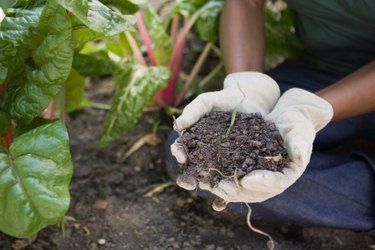
As with all living organisms, chemical elements make up the different compounds and organelles found inside plant cells. Plants absorb the elements that make up their cellular structure from air, water and the minerals that they take up with their roots. Not surprisingly, the elements that you find most often in a plant cell tend to match the elements that you find in a bag of fertilizer. Nine non-mineral and 13 mineral elements make up a plant cell.
Carbon
Video of the Day
Carbon forms the most essential element found in all organic life, including plant cells. Plants absorb carbon dioxide from the air, using energy from the sun to combine the carbon dioxide with water to form sugar and oxygen. The ability of plants to take carbon from the air and incorporate it into their biomass leads to their designation as carbon sinks: organisms that remove potentially harmful carbon dioxide and turn it into beneficial organic matter. All parts of plant cells include carbon.
Video of the Day
Nitrogen
All life requires nitrogen. Animals, including humans, consume nitrogen in the form of protein, but plants take up inorganic nitrogen through their root systems, according to Florida State University's Molecular Expressions website. Nitrogen forms an essential component of all plant cells, forming proteins, enzymes and chlorophyll and helping with the synthesis and transfer of energy. All plant cells contain a nucleus that holds the plant's genetic material. The DNA found there consists of a number of elements, including nitrogen. DNA stores the plant's genetic code and passes it on to its offspring.
Calcium
All plant cells contain a rigid cell wall, which gives the cell its boxy shape; multiple plant cells in turn give plants their rigid structure, control the passage of water and compounds in and out of the cell, regulate growth and protect the cell from disease. Just as calcium provides bone structure in animals, it contributes to the structure of the cell wall, according to the North Carolina Department of Agriculture.
Potassium
Plants absorb more potassium, nitrogen and calcium from the soil than any other element. Potassium plays several important roles inside each plant cell, including incorporating itself into cellular proteins. Potassium forms part of the sodium-potassium pump, a mechanism embedded into the plant's cellular membrane, as well as the membranes enclosing individual organelles inside the cell. The membranes use energy to actively transport potassium to one side of the membrane. When concentrations build up on one side, the potassium flows to the other side of the membrane, carrying with it other molecules that the cell or organelle needs.
- Florida State University: Molecular Expressions: Plant Cell Structure
- North Carolina Department of Agriculture: Plant Nutrients
- Princeton University WordNet: Organic Compound
- Greenhouse Gases Online: Carbon Dioxide Sinks -- Plants
- Community College of Baltimore County: The Four Nitrogenous Bases in DNA
- Universität Hamburg: Active Transport